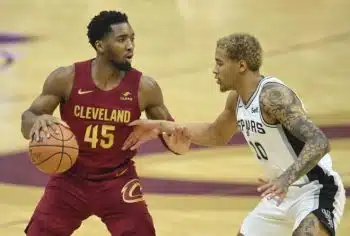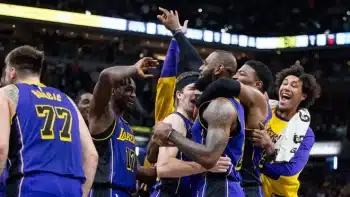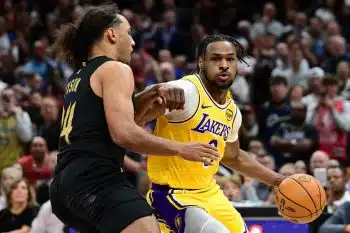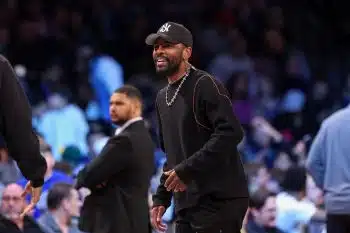NBA
NBA PM: The Problems with Restricted Free Agency
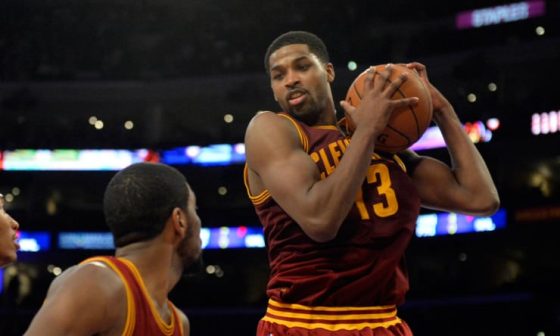
The issue of player movement is under the microscope after Kevin Durant decided to leave the Oklahoma City Thunder to join the Golden State Warriors this month. The NBA has a number of rules and restrictions in place that are designed to help teams retain their players while still allowing individuals the flexibility to periodically switch teams if they so choose.
The most problematic portion of this system of rules and regulations is restricted free agency. Players become restricted free agents in limited circumstances, most often after the fourth year of rookie-scale contracts for first-round draft picks. If a team extends a qualifying offer, it can then match any offer sheet that player signs. This system is of course designed to help teams retain their key players, but there are some negative consequences for both the teams and the players.
First, any restricted free agent who isn’t a star or budding star will likely face an artificially dry market. This is the case since teams that otherwise would be interested in a particular restricted free agent often know that the player’s original team will very likely match any semi-reasonable offer sheet. Aside from completely overpaying a restricted free agent, there aren’t many effective ways to structure an offer sheet to deter the original team from matching.
Another reason why teams shy away from chasing restricted free agents is because it will likely limit their ability to pursue desirable unrestricted free agents. Teams are allowed to contact and negotiate deals with free agents starting on July 1. However, players are not allowed to actually sign a contract until the end of the moratorium, which lasted from July 1 until July 7 this year.*
Furthermore, once an offer sheet has been signed, the original team has three days to match it. This means that if a team set aside $20 million for a restricted free agent this offseason, that money would be tied up until July 9 once the original team matches or opts not to. In the meantime, other players will be flying off the free agency board as other teams rush to make deals before the free agency pool dries up. This is a huge risk for teams, especially when you consider how often restricted free agent offer sheets are matched. And even if a team chooses not to match, the primary reason is likely that the offer sheet is unreasonably high and exceeds the player’s estimated worth at that point in time. There are some circumstances where teams are comfortable severely overpaying a restricted free agent, but in general it’s still a problematic means of adding talent.
This creates problems for the restricted free agents as well. The obvious result of this system is that unrestricted free agents will almost always be pursued first. This means that by the time teams collectively set their sights on the bulk of the restricted free agents, the majority of the teams’ spending power may be used up. This may not be a major issue for star-caliber players, who will ultimately receive a sizable contract, but it is for the average role player.
This often leaves players in a tough position. The player must determine if he should accept whatever offer his original team has put on the table, continue waiting for another team to step with a big offer sheet, accept the original team’s qualifying offer to become an unrestricted free agent the following offseason or perhaps even hold out for a bigger deal, as Tristan Thompson almost did when he was a restricted free agent last summer in negotiations with the Cleveland Cavaliers.
We saw a rare example of a player taking the qualifying offer in 2014 when Greg Monroe did so with the Detroit Pistons. Monroe opted to earn $5.5 million that season, passing on a reported deal worth somewhere between $50-$60 million. In doing so, Monroe became an unrestricted free agent after the season and signed a three-year, $50 million deal with the Milwaukee Bucks. Monroe’s contract with Milwaukee isn’t a max-level deal, but he is earning roughly $3 million more per season than he would under Detroit’s offer and he had the freedom to choose where he would play – a luxury that has a lot of value to most players.
While things worked out contractually for Monroe, there is a reason why the vast majority of players pass on their respective qualifying offers. First off, the player is likely losing significant salary for that single season, as we saw in the case of Monroe. Also, injuries can happen at any time as we know too well. So if a player accepts their qualifying offer and then suffers a catastrophic injury, they have no long-term security and will likely enter unrestricted free agency at a disadvantage (depending on the severity and long-term prognosis of the injury).
While Michael Kidd-Gilchrist likely would have signed a much better deal as a restricted free agent, he did land financial security in signing a rookie extension last summer. Shortly after doing so, he dislocated his shoulder and partially tore his labrum during one of the Charlotte Hornets’ preseason games last October. He then suffered a second shoulder injury toward the end of last season, shortly after recovering from the first injury. In signing an extension, he locked in a lot of money and protected himself against the risk of injury. However, Kidd-Gilchrist is highly thought of around the league and it’s hard to imagine him not landing somewhere close to the four-year, $90 million max-level offer sheet he was eligible for, even after suffering the shoulder injuries.
Jimmy Butler and Tobias Harris both passed on sizable extensions from their respective teams and entered restricted free agency. Harris passed on signing an extension in 2014 and landed a four-year deal worth $64 million from the Orlando Magic the following offseason. Butler reportedly informed the Chicago Bulls that he would agree to a four-year, $48 million extension, which the team reportedly would not offer. Butler subsequently had a career-year and landed a five-year, $95 million deal from the Bulls as a restricted free agent. As you can see, any player displaying a developing game, under the current system, should most likely pass on signing a rookie extension and instead test restricted free agency.
While Harris and Butler came out ahead with their decisions, it doesn’t always work out that way for players. Another notable issue that comes up with restricted free agency is the animosity that can brew between a player and his team. It’s usually difficult determining what a player is actually worth in terms of dollars and years, and determining this becomes even more difficult when the market is artificially cooled by a system that deters teams from pursuing a certain class of players.
While players like Tristan Thompson and Eric Bledsoe, among many others, may think they are worthy of max-deals, their team’s executives may disagree. In the case of Thompson and Bledsoe, both players went through a lengthy negotiation process that got nasty at times. While players and executives are professionals and often get past any hard feelings that come up during the negotiation process, there’s little doubt that oftentimes this process dampens whatever positive feelings both sides may have had for the other.
Having said all of this, we did see some examples this offseason of role players getting significant contracts as restricted free agents. Orlando’s Evan Fournier (five years, $85,000,000), Portland’s Allen Crabbe (four years,$75,000,000), Miami’s Tyler Johnson (four years, $50,000,000) all signed bigger deals than anyone reasonably expected for differing reasons. Fournier proved himself to be a deadly shooter last season and fills a bigger role now that Victor Oladipo plays for the Oklahoma City Thunder. Crabbe and Johnson both got huge deals partially because the Brooklyn Nets lack assets and draft picks to acquire young talent and were thus willing to overpay to add some promising players to their roster. Nevertheless, restricted free agency is problematic in several ways and is something that likely will be adjusted in the next Collective Bargaining Agreement.
So how can the NBA and the Players’ Association address the problems with restricted free agency during their labor negotiations? There aren’t any obvious answers to this question, but here are a few thoughts on the issue:
1. Create early extensions for rookie-scale contracts
One of the easiest ways to avoid losing a player in free agency is to extend their existing contract before they hit free agency. This could be particularly useful for rookie-scale contracts since they are not tied to the salary cap, which means they do not increase as the cap increases. This is why productive players on rookie deals are such valuable commodities – they are heavily cost-controlled.
Nate Duncan of The Cauldron spoke with league executives earlier this year and one change that received strong support was a rule that would allow teams the option to extend players after the second season of their rookie contracts:
If such an extension were not agreed to, the last two years of the rookie contract would operate normally, but the player would become an unrestricted free agent after the fourth year, rather than a restricted free agent as under the current system. Under this proposal, the thinking goes, a team that really viewed a player as part of its future and wanted to keep him from unrestricted free agency would be forced to free him from the indentured servitude of the rookie-scale deal. But, much as in baseball, teams could still get discounts on these extensions, because the player would be motivated to agree rather than go through two more cheap years on the original deal.”
This makes sense for several reasons. As Duncan stated, the team has a means to delay its player from becoming an unrestricted free agent, while significantly increasing the player’s annual salary. While this approach may not be appealing for teams or players in every situation, it offers some incentive to both sides to extend the length of their contractual relationship.
2. Shorten the period teams are given to match an offer sheet
If one of the major deterrents to pursuing restricted free agents is the three-day period for the original team to match, then why not shorten that period? Limiting the period to exercise the right of first refusal to one day may be harsh, but perhaps 36 hours or even two days would be a fair compromise. This solution only address one of several problems associated with restricted free agency, so this would have to be just one component of several other amendments.
3. Expand incentives teams can include in offer sheets
Under the current system, teams cannot offer contracts as long as a restricted free agent’s original team, nor can it offer comparable annual raises. These rules are in place to theoretically give a restricted free agent’s original team an advantage in keeping its players, but that consequently prevents other teams from structuring offers that the player’s original team may think twice about matching, which has the effect of chilling the market for many restricted free agents. While teams typically use trade kickers, poison pills and player options, there could be more incentives so a team may feel more confident in their ability to structure a deal that a restricted free agent’s original team may pass on. Even if teams still match these offer sheets at a high rate, at least other teams will feel somewhat more confident in their ability to effectively pursue restricted free agents.
4. Getting rid of restricted free agency altogether
This is a drastic approach that team owners would likely never agree to without significant concessions elsewhere. The ability to retain a player for several seasons is a major tool for teams, so getting rid of it altogether could cause even more player movement than we currently see in free agency. However, removing a safeguard like this would incentivize teams to run their respective franchise’s as effectively as possible in order to make itself a desirable destination for free agents, while teams that are run incompetently would necessarily flounder. Again, this is a drastic measure that owners would most likely never agree to, but there is some merit to removing a flawed system that is designed to protect owners.
*****
These are just a few proposed solutions to a series of issues with restricted free agency. If you think you have the solution, be sure to leave your thoughts or suggestions in the comment section below.

